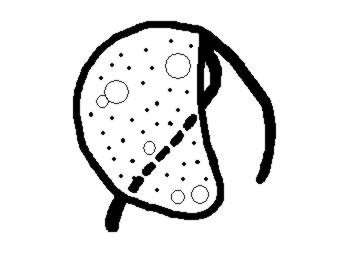- Cafeteria roenbergensis
taxobox
color = khaki
name="Cafeteria roenbergensis"

image_caption = "Cafeteria roenbergensis"
domain =Eukaryota
regnum =Chromista
subregnum =Chromobiota
infraregnum =Heterokonta
phylum =Opalozoa
subphylum =Sagenista
classis =Bicosoecophyceae
ordo =Bicosoecales
familia =Cafeteriaceae
genus = "Cafeteria"
genus_authority = Fenchel & Patterson, 1988
species = "C. roenbergensis"
species_authority = Fenchel & Patterson, 1988"Cafeteria roenbergensis" is a
marine Bicosoecid described in1988 byFenchel andD.J. Patterson . It is the first known species of "Cafeteria ".Description
Cafeteria roenbergensis is D-shaped and has a volume of around 20 µm3. Being a
eukaryotic organism it has a nucleus,mitochondria and other subcellular compartments. The posteriorflagellum attaches the organism to the substrate while it is feeding. If it detaches, the cell will swim around being pulled forward by the beating of the anteriorflagellum . When feeding, the action of the flagellum creates a current of water that moves towards the cell. The current carriesbacteria - the primary food of the flagellate. The food is ingested below the base of the flagella – this is referred to as the ventral side. The flagella are anchored by ‘rootlets ’ ribbons and subcellular ropes. They act as askeleton and also support the mouth region.Trivia
Cafeteria roenbergensis occurs in all oceans in which they have been looked for, and can grow to very high concentrations (in excess of 10,000 per ml).
Of all
eukaryotes studied, this species have the most functionally compact DNA – with only 3.4% not being used for coding purposes.Cells can replicate in under 10 hours. They reproduce by
binary fission , first replicating the flagella and internalorganelles before the cell divides. Nosexual activity is known for this species.The flagella beat about 40 times per second, and they create a water current that moves about 100 microns / second.
References
[http://www.eol.org/taxa/16222828 Encyclopedia of Life]
Wikimedia Foundation. 2010.
